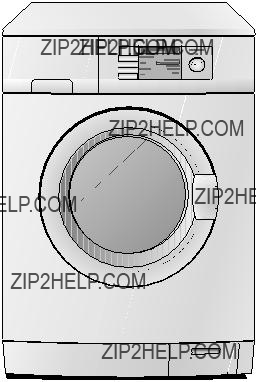
LAVAMAT
LAVALOGIC 1620
Washing Machine
User information

LAVAMAT
LAVALOGIC 1620
Washing Machine
User information

Dear Customer,
Please read this user information carefully and keep it to refer to later. Please pass the user information on to any future owner of the appli- ance.
The following symbols are used in the text:
1 Safety instructions
Warning! Information that affects your personal safety. Important! Information that prevents damage to the appliance.
3 Useful tips and hints
2 Environmental information
2

3

Child safety device. . . . . . . . . . . . . . . . . . . . . . . . . . . . . . . . . . . . . . . . . . . . . . 27
What to do if.... . . . . . . . . . . . . . . . . . . . . . . . . . . . . . . . . . . . . . . . . . . . . . . . . 29 Remedying small malfunctions yourself . . . . . . . . . . . . . . . . . . . . . . . . . . . . . 29 If the wash result is not satisfactory . . . . . . . . . . . . . . . . . . . . . . . . . . . . . . . . 31 Carrying out an emergency drain . . . . . . . . . . . . . . . . . . . . . . . . . . . . . . . . . . 32 Drain pump. . . . . . . . . . . . . . . . . . . . . . . . . . . . . . . . . . . . . . . . . . . . . . . . . . . . . 33
Technical data. . . . . . . . . . . . . . . . . . . . . . . . . . . . . . . . . . . . . . . . . . . . . . . . . . 35
Consumption values. . . . . . . . . . . . . . . . . . . . . . . . . . . . . . . . . . . . . . . . . . . . . 35
Installation and connection instructions. . . . . . . . . . . . . . . . . 36
Safety information concerning installation . . . . . . . . . . . . . . . . . . . . . . . . 36
Installing the appliance . . . . . . . . . . . . . . . . . . . . . . . . . . . . . . . . . . . . . . . . . 37 Transporting the appliance . . . . . . . . . . . . . . . . . . . . . . . . . . . . . . . . . . . . . . . . 37 Removing the transit packaging . . . . . . . . . . . . . . . . . . . . . . . . . . . . . . . . . . . 37 Where to install . . . . . . . . . . . . . . . . . . . . . . . . . . . . . . . . . . . . . . . . . . . . . . . . . 38 Making the appliance level. . . . . . . . . . . . . . . . . . . . . . . . . . . . . . . . . . . . . . . . 39
Connecting the appliance to the water supply . . . . . . . . . . . . . . . . . . . . . 41 Water inlet . . . . . . . . . . . . . . . . . . . . . . . . . . . . . . . . . . . . . . . . . . . . . . . . . . . . . 42 Water Drainage . . . . . . . . . . . . . . . . . . . . . . . . . . . . . . . . . . . . . . . . . . . . . . . . . 43
Customer Service Centres . . . . . . . . . . . . . . . . . . . . . . . . . . . . . . . . . 47
Service and Spare Parts . . . . . . . . . . . . . . . . . . . . . . . . . . . . . . . . . . . 51
4

Operating Instructions
1 Safety
Prior to using the appliance for the first time
???Follow the ???Installation and connection instructions???.
???If the appliance is delivered in the winter months when there are mi- nus temperatures: store the washing machine at room temperature for 24 hours before using for the first time.
Correct use
???The washing machine is only designed for the washing of normal do- mestic laundry at home.
???Additions or modifications to the washing machine are not permit- ted.
???Only use detergents/conditioners that are suitable for use in domestic washing machines.
???The washing must not contain any flammable solvent. The risk of ex- plosion exists.
???Do not use the washing machine for dry cleaning.
???Dyes/colour removers may only be used in the washing machine, if the manufacturer of these products expressly permits this. We cannot accept liability for any damage arising.
Child safety
???Keep packaging away from children. There is a risk of suffocation.
???Children often do not recognise the hazards associated with electrical appliances. Don???t allow children to use the washing machine unsu- pervised.
???Make sure that children and pets don???t climb into the drum of the washing machine. The risk of death exists.
5

General safety
???Repairs to the washing machine may only be carried out by qualified/ authorised service engineers.
???Never use the appliance when the electrical cable is damaged or the control panel, worktop or plinth area are damaged to such an extent that the inside of the appliance is openly accessible.
???Switch off the washing machine prior to cleaning it and carrying out maintenance. In addition, remove the power plug from the power point or ??? if the appliance has been
???If operation is stopped, disconnect the appliance from the mains sup- ply and turn off the tap.
???Never remove the power plug from the power point by pulling on the cable. Always pull the plug.
???
Resulting overheating may constitute a fire hazard.
???Never wash the washing machine down with a water jet. Danger of electric shock.
???When using wash programmes with high temperatures the glass in the door will become hot. Do not touch it!
???Before emergency emptying of the appliance, before cleaning the drain pump or opening the door in an emergency, let the water cool down.
???Small animals can nibble on electrical cables and water hoses. This can constitute a risk of electrocution and water damage. Keep small animals away from the washing machine.
6

Switching on the appliance for the first time
??? setting the language
When switching on the appliance for the first time you should be sure to set the language in which you want the indicators in the display to appear.
1. Press the control knob. The appliance is now switched on. The languages that can be chosen will ap- pear in the display. In the factory the language is pre- set to German.
Important: If the display is not showing any languages, the appliance has been switched on before. If this happens, please see the section ???Setting extra options: Language???, if you want to change the language setting.
2.Use the control knob to highlight the desired lan- guage.
3.Press the SELECT key.
From now on all indicators in the display will appear in this language.
4.Press the control knob to switch off the appliance.
7

Description of the appliance
Control panel with display
Drawer for detergent and conditioner
Rating plate (behind door)
Door
Control panel with display
Display
Indicators in the display
8

Main control features
Control knob
Switching the appliance on and off
Press the control knob to switch the appliance on and off.
Highlighting
You can highlight the entries on the right of the display by turning the control knob.
WOOLLENS 40??C
Cancelling settings
If you would like to cancel settings that have been made by mistake, switch the appliance off and on again using the control knob. You are now able to
Keys
Using the keys you can:
???activate an entry on the
???change the temperature and the spin speed
???select OPTIONS and EX- TRAS.
3 You can set one or more options for each programme.
The basic rule: First set the programme, then set the option.
3 The programmes and functions are divided into different levels and pages. In the navigation display you can see the level and the page you are currently on (e.g. ??: level 3, page 1 of 2).
9
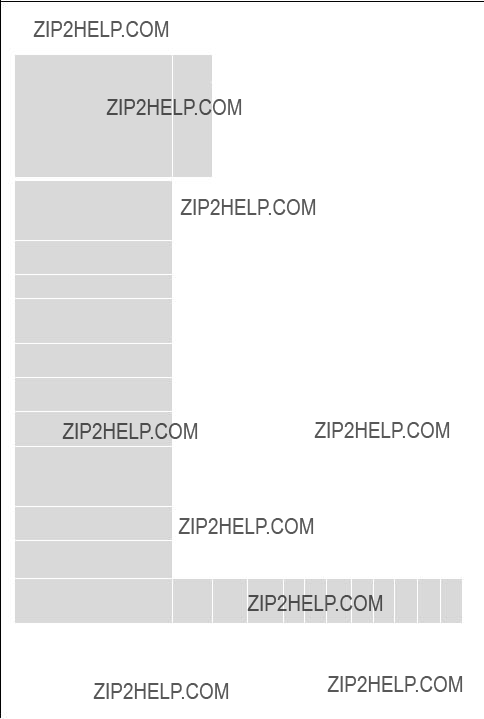
Programme overview
Programme
ENERGY SAVING4)
COTTONS 95
DELICATES 40, 30, 20
WOOL  (Handwash)
(Handwash)
40, 30, COLD
SILK  (Handwash) 30
(Handwash) 30
LINGERIE 40
40
EASY IRON
60, 50, 40, 30, 20
REFRESH 30
FASHION 40
1)In the case of excessively large volume washing of a fleecy nature, e.g. terry towelling, flannelette, it may be that the drum is already full before the maximum load is reached.
2)Recommended load for short progammes is 3,5kg; full loading is possible however with somewhat reduced cleaning results.
3)STAIN can only be selected with wash temperatures of 40??C and above, as stain treatment products are only effective at higher temperatures.
4)Programme settings for tests in accordance with or support of EN 60 456 and IEC 60 456 are described in the section ???Consumption values???.
10
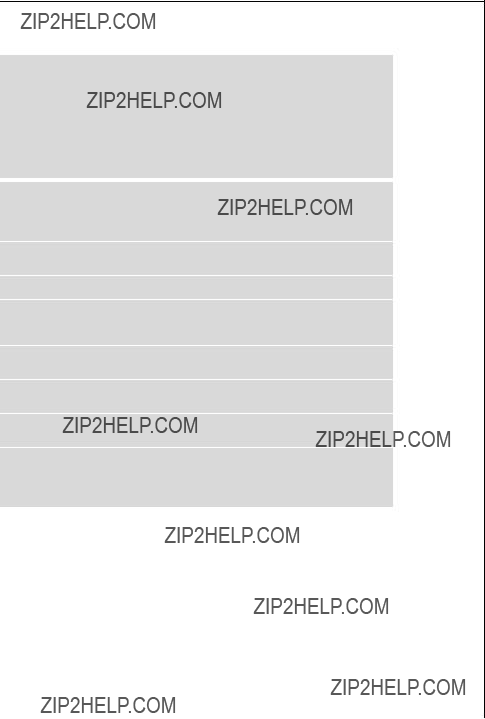
1) The figures in the care symbols indicate the maximum temperatures.
11

12

1) The figures in the care symbols indicate the maximum temperatures.
13

Before the first wash
Setting the time
So that the current time and the end of the programme are correctly displayed, please check the display and set the current time, if neces- sary. (See ???Setting extra options: Timer???.)
Carrying out a wash programme prior to first use
Before doing your first wash, run a washing cycle without any washing in the machine (programme
This will remove any residues from the drum and water container which have been left as a result of the production process.
Preparing and sorting washing
Preparing washing
???Empty the pockets. Remove foreign bodies (e.g. coins, paper clips, nails, etc.).
???Do up zips, button up covers to prevent damage to washing.
???Remove the runners from net curtains or cover them with a net or a bag.
???Wash delicate and small items in a net/pillowcase, e. g. net curtains, tights, small socks, handkerchiefs, bras.
Important: Bras and other items containing wires should only be washed in a net bag. The wires can work loose and damage the appli- ance.
Sorting washing
???By colour: Wash white and coloured washing separately. Washing can run.
???By temperature, type of washing and care symbol.
Important: Do not wash fabrics with the Gcare symbol (= do not wash!) in the washing machine.
14

Running a wash cycle
Switching on the appliance
Press the control knob. The appliance is now switched on.
3 Before switching the appli- ance on, make sure that the drum is empty. If you do not,
the washing will subse-
quently not be registered properly by the load sensor.
Setting a programme
5.Highlight the desired pro- gramme, e.g. DELICATES.
DELICATES 40??C
Changing the temperature
6.Press the temperature key repeatedly, until the desired temperature appears, e.g. 30??C. Please note: a temper- ature cannot be increased for fabric type selected. Only decreased.
DELICATES 30??C
Changing the spin speed
7.Press the key for the spin speed repeatedly until the desired spin speed appears e.g. 1000 or the RINSE HOLD. Please note: the spin speed cannot be increased for a fabric type selected. Only de- creased.
15

3 RINSE HOLD means: the washing is left to soak in the last rinse water and is not spun.
If required, set options.
Selecting options
You can select different options on top of the programme that has been selected. Only options that can be combined with the programme that has already been selected will be offered.
16

TIME SAVING
1.Press the OPTIONS key.
2.Use the control knob to highlight TIME SAVING.
3.Press the SELECT key.
4.Use the control knob to highlight VERY QUICK.
5.Press the SELECT key. The 
 symbol appears in the display.
symbol appears in the display.
DELICATES 30??C
DELAY START
1.Press the OPTIONS key.
2.Use the control knob to highlight DELAY START.
3.Press the SELECT key.
4.Use the control knob to highlight the time at which the programme is to end.
5.Press the SELECT key. The programme end time will change in the information panel.
6.Press the START key.
DELICATES 30??C
Cancelling DELAY START: Press the START key again. The wash programme will start immediately.
SENSITIVE/STAIN/PRE WASH
1.Press the OPTIONS key.
2.Use the control knob to highlight PRE WASH.
3.Press the SELECT key.
The  symbol appears in the display.
symbol appears in the display.
DELICATES 40??C
17

Opening the door/Loading the washing
1. To open the door: carefully pull the handle on the door. 2. Unfold the washing and load it  loosely into the machine. Mix large
loosely into the machine. Mix large 
and small items. Important: Do not get any washing
caught between the door and the rubber seal.
3. Push the door firmly shut.
CURRENT LOAD/DETERGENT display
???the maximum permissible loading for the programme marked,
???the actual loading. This is also displayed by the bars (loads of less than 0.5kg are not displayed),
???and washing agent measurement, with reference to the volume of laundry, as recommended by the washing agent manufacturer.
If too much laundry has been loaded into the machine, the following indicator appears in the display OVERLOADING. Please remove the rele- vant amount of laundry in such cases.
Press any button or turn any knob to undertake more programme settings.
3 If the laundry is removed again before the programme starts, the CURR. LOAD display may not change back to 0. If this occurs, please turn the machine off and switch it back on again after approx. 3 seconds. Reset the programme and refill machine with laundry.
The CURR. LOAD display goes out if the machine is closed.
18

Adding detergent/conditioner
Important: Only use detergents/conditioners that are suitable for use in domestic washing machines.
Add detergent/conditioner in accordance with the detergent/condi- tioner manufacturer???s instructions. Observe instructions on the packag- ing.
The amount of detergent used depends on:
???the washing???s degree of soiling,
???the load size
???the hardness of the tap water.
Water softener should be used from water hardness range 2 (=medi- um). The amount of detergent used can then always be that as for hardness range 1 (=soft). Your local water company will provide you with information about water hardness in your area.
The suggested dosage in the display may therefore just be a guideline.
1.Pull out the detergent drawer as far as it will go.
2.Add the detergent/conditioner.
3.Push the detergent drawer in fully.
Washing powder/tablets for the main wash cycle
If you are using water softener and require the right compartment for detergent for the
Softener,
Fill the compartment to no more than the MAX indicator. Add water to thick liquid concentrates in accordance with the manufacturer???s in- structions before using them. Dissolve powder starches.
If you are using liquid detergent:
Add liquid detergent using the dosage containers provided by the de- tergent manufacturer.
19

Starting a programme
1.Check that the water tap is open.
2.Press the START key. The wash cycle is started.
DELICATES 30??C
Programme progress
While the programme is running, the display shows among other things:
???each stage of the pro- gramme as it progresses, e.g. MAIN WASH,
???a bar showing the progress of the programme,
???the expected residual moisture in the washing at the end of the pro- gramme.
Interrupting a programme/Adding washing
Interrupting a programme
???The wash programme can be temporarily interrupted at any time by pressing the PAUSE key. It is then
???To cancel a programme before it has finished, switch off the appli- ance (press the control knob).
Adding washing
The padlock symbol in the display indicates whether washing can still be added after the programme has started:
It is not possible to add washing (Door is locked because of high water level or high temperature).
It is possible to add washing.
1.Press the PAUSE key. The  symbol appears in the display.
symbol appears in the display.
2.Open the door. Be cautious that any water in the drum may be hot and there is a risk of scalding.
3.Add washing, close the door again.
4.Press the START key.
20

Washing cycle complete/Removing the washing
At the end of the programme PLEASE TAKE OUT THE CLOTHES appears in the display. As soon as the  ?? symbol appears, the door can be opened.
?? symbol appears, the door can be opened.
1.Open the door using the handle.
2.Remove the washing.
3.Close the water tap.
4.Switch off the appliance.
If Rinse Hold has been selected:
1. Press the START key.
The display automatically changes to the first pro- gramme page. Depending upon the programme that has been running either SPIN or SHORT SPIN is highlight- ed.
SHORT SPIN
3.Press the START key.
The washing is spun or the water is drained.
3 If OVERDOSING is shown in the display at the end of a wash cycle, too much detergent was used in the completed wash programme. Please take note of the dosage instructions provided by the detergent manu- facturer and the amount of washing loaded the next time you wash.
21

Setting extra options
Independent of any programme you can set different basic settings. These basic settings will permanently remain active until they are dese- lected again.
22

MEMORY
Saving a programme setting
First set a programme (e.g.
1.Use the control knob to highlight
2.Set the temperature and the spin speed.
3.Press the OPTIONS key.
4.Highlight the SENSITIVE op- tion.
5.Press the SELECT key.
The  symbol will appear in the display.
symbol will appear in the display.
6.Press the EXTRAS key. MEMORY is highlighted:
7.Press the SELECT key.
If MEMORY 1 is highlighted:
8.Press the SAVE key.
The programme setting is stored as M1:
9.Then press the BACK key 3 times.
23

Clearing a stored programme setting
1.Press the OPTIONS key.
2.Press the EXTRAS key. MEMORY is highlighted:
3.Press the SELECT key.
4.Use the control knob to highlight MEMORY 1.
5.Press the CLEAR key.
The stored programme set- ting has now been cleared.
6.Then press the BACK key 3 times.
RINSE+, GENTLE SPIN
1.Press the OPTIONS key.
2.Press the EXTRAS key.
3.Use the control knob to highlight the desired Extra, e.g. RINSE+.
4.Press the SELECT key.
The  symbol appears in the display.
symbol appears in the display.
5.Press the BACK key twice.
24

LANGUAGE
1.Press the OPTIONS key.
2.Press the EXTRAS key.
3.Use the control knob to highlight LANGUAGE.
4.Press the SELECT key.
5.Use the control knob to highlight the desired lan- guage, e.g. ENGLISH.
6.Use the SELECT key to store the selected language.
7.Press the BACK key 3 times.
TIMER
1.Press the OPTIONS key.
2.Press the EXTRAS key.
3.Use the control knob to highlight TIMER.
4.Press the SELECT key.
5.Use the control knob to set the desired time.
6.Press the SELECT key.
7.Press the BACK key 3 times.
VOLUME
1.Press the OPTIONS key.
2.Press the EXTRAS key.
3.Use the control knob to highlight VOLUME.
4.Press the SELECT key.
5.Use the control knob to highlight OFF, NORMAL or LOUD.
6.Press the SELECT key.
7.Press the BACK key 3 times.
25

Programme protection
In order to protect the selected settings of a programme that is running from unintentional alterations, the buttons can be locked.
Setting programme protection:
1. Start the programme.
2.Press second and fourth but- ton at the same time for
about 3 seconds. In the dis-
play the symbol  appears. The buttons are locked.
appears. The buttons are locked.
Removing programme protection:
Press second and fourth button again for about 3 seconds. The buttons are unlocked. The symbol  disappears.
disappears.
3 The buttons also remain locked after the appliance has been switched off. Before the next wash, remove programme protection again, so that a new programme can be set.
If the appliance is unintentionally switched off while a programme is running, programme protection must first be removed. Then set and start the programme again.
26

Child safety device
If the child safety device has been activated, the door can no longer be shut.
Activating the child safety device:
Use a coin to turn the knob (on the inside of the door) in a clockwise di- rection as far as it will go.
1 Warning! The knob must not be de- pressed after being set, otherwise the child safety device is not acti- vated. The knob must stand proud as shown in the illustration.
Deactivating the child safety device:
Turn the knob in an
27

Cleaning and care
Important: Do not use furniture cleaning products or aggressive clean- ing agents to clean the appliance.
Wipe over the control panel and housing with a damp cloth.
Detergent drawer
The detergent drawer should be cleaned regularly.
1.Remove the detergent drawer by pulling firmly.
2.Remove the softener insert from the
middle compartment.
3. Clean all parts with water.
4. Place the softener insert in as far as it will go, so that it is firmly in posi- tion.
5.Clean the entire drawer recess area of the washing machine, in particu-
lar the jets on the upper side of the
6. Place the detergent drawer in its guide rails and push it in.
Washing drum
Rust deposits in the drum may occur due to rusting foreign bodies in the washing or tap water containing iron.
Important! Do not clean the drum with acidic descaling agents, scour- ing agents containing chlorine or iron or steel wool.
1.Remove any rust which has accumulated in the drum using a cleaning agent for stainless steel.
2.Run a washing cycle without any washing to clean off any cleaning agent residues. Programme:
Door and rubber collar
Regularly check whether deposits or foreign substances are present in the folds of the rubber collar or inside on the door glass.
Regularly clean the door glass and the rubber collar.
28

What to do if...
Remedying small malfunctions yourself
If one of the following fault messages is shown in the display during operation:
???ATTENTION (E41)/PLEASE CLOSE THE DOOR
???ATTENTION ERROR CODE (E11)/PLEASE OPEN THE TAP
???ATTENTION ERROR CODE (E21)/PLEASE CHECK THE WATER
DRAINAGE
please refer to the following table.
After you have rectified the error, press the START key.
If ATTENTION/PLEASE CALL YOUR LOCAL SERVICE FORCE together with an error code (e.g. E..) appears in the display: Switch the appliance off and then on again.
If the error code is displayed again, please contact the Service Force and inform them of the error code and the PNC no. (see rating plate).
29

30

If the wash result is not satisfactory
The washing is grey and there are limescale deposits in the drum
???Too little detergent was used.
???An incorrect detergent was used.
???Individual stains were not
???The programme or temperature was not set properly.
There are grey stains on the washing
???Items that were soiled with ointments, fats or oils were washed using too little detergent.
???The wash temperature used was too low.
???A common cause is that conditioner ??? in particular the type in con- centrated form - has come in contact with the washing. Wash out such marks as soon as possible and exercise care when using the said conditioner.
Foam can still be seen following the final rinse
???Modern detergents can cause foam to be created even during the fi- nal rinse. In spite of this, the washing has been sufficiently rinsed.
There are white residues on the washing
??? What can be seen here are insoluble substances which modern deter- gents contain. They are not the result of insufficient rinsing.
Shake or brush the washing. If possible turn the washing inside out before washing. Check your choice of detergent. Especially with dark
colours it is advisable to use liquid detergents.
31

Carrying out an emergency drain
1 Warning! Prior to carrying out an emergency drain, switch off the washing machine and remove the power plug from the power point. Warning! The water that comes out of the emergency drain hose may be hot. There is a risk of scalding. Let the water cool before performing an emergency drain!
1. Open the plinth flap and remove it.
2. Remove the emergency drain hose.
3. Place a shallow container under- neath it. Then loosen the drain plug by turning it in an
4. The water will run out. If it is neces- sary to empty the container more than once, seal up the emergency drain hose with the drain plug while you are doing so.
When the water has all drained away:
5.Insert the plug firmly into the emergency drain hose and turn it in a clockwise direction until it is firmly in place.
6.Replace the emergency drain hose into the retainer.
7.Insert the plinth flap into place and close it.
32
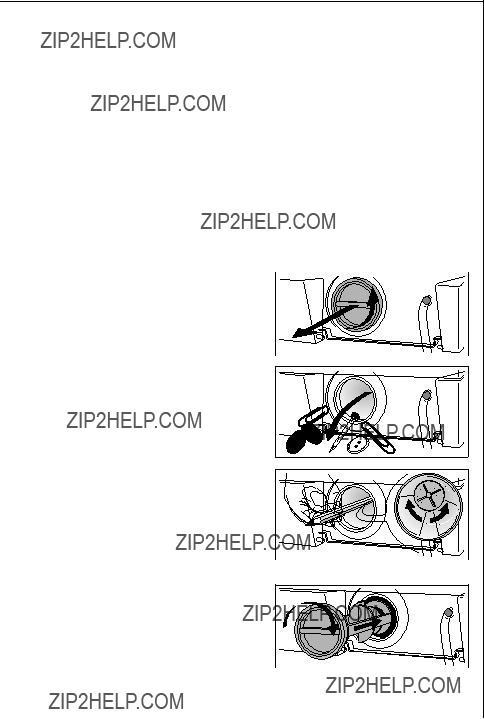
Drain pump
The drain pump is
Before loading the machine, please always ensure that there are no for- eign bodies present in the pockets or in between the items to be washed. Paper clips, nails, etc. which may find their way into the wash- ing machine along with the washing will remain in the drain pump housing (foreign body trap that protects the pump wheel).
1 Warning! Before opening the cover of the drain pump, switch off the washing machine and remove the power plug from the power point.
1.First carry out an emergency drain.
2.Place a cloth on the floor in front of the cover of the drain pump. Residual water runs out.
3.Unscrew the pump cover in an anti-  clockwise direction and remove it.
clockwise direction and remove it.
4. Remove foreign bodies and fluff from the pump housing and from the pump wheel.
5. Check whether the pump wheel right at the back of the pump hous- ing can turn. (If the wheel rotates with a jerky motion, this is normal.) If the pumping wheel cannot be turned, please contact your local Service Force Centre.
6. Insert the pump cover. Insert the guides at the sides of the cover into the guide slots and tighten the cov- er by turning in a clockwise direc- tion.
7.Close off the emergency drain hose and place it in the retainer.
8.Close the plinth flap.
33

Disposal
2 Packaging material
The packaging materials are environmentally friendly and can be recy- cled. The plastic components are identified by markings, e.g. >PE<, >PS<, etc. Please dispose of the packaging materials in the appropriate container at your local waste disposal facilities.
2 Old appliance
The symbol Won the product or on its packaging indicates that this product may not be treated as household waste. Instead it shall be handed over to the applicable collection point for the recycling of elec- trical and electronic equipment. By ensuring this product is disposed of correctly, you will help prevent potential negative consequences for the environment and human health, which could otherwise be caused by inappropriate waste handling of this product. For more detailed infor- mation about recycling of this product, please contact your local city office, your household waste disposal service or the shop where you purchased the product.
1 Warning: When your appliance has finished its working life, remove the plug from the mains socket. Cut off the cable and plug and dispose of them.
Destroy the door lock. This prevents children from trapping themselves inside and endangering their lives.
34

Technical data
Consumption values
The consumption values for selected programmes provided in the fol- lowing table were determined under standard conditions. They may vary when operating in domestic conditions.
1)The load is determined in accordance with the EN 60456 standard load.
2)Note: Programme setting for tests in accordance with or supporting EN 60 456 and IEC 60 456. Consumption values will vary from the values quoted depending on wa- ter pressure, water hardness, water temperature at filling, room temperature, type and quantity of washing, detergent used, variations in mains voltage and any options selected.
35

Installation and connection instructions
1Safety information concerning installation
???This washing machine cannot be
???Before using for the first time, check the appliance for damage sus- tained while it was being transported. Do not under any circumstanc- es connect an appliance that is damaged to the mains. In the event of damage to the appliance contact your supplier.
???Be sure to remove all the components of the transit packaging before using the appliance for the first time. Otherwise when spinning dam- age may be caused to the appliance or to neighbouring units or fur- niture.
???Before using the appliance for the first time, splash protection must be completed. (See ???Removing transit packaging???).
???Always plug the mains plug into a correctly installed shockproof socket.
???If
???Prior to using the appliance for the first time, ensure that the rated voltage and current on the rating plate match the mains voltage and current where the appliance is to be installed. The required fuse pro- tection is also to be found on the rating plate.
???If work on the plumbing is required for the proper connection of the washing machine to the water supply, this must be undertaken by a registered plumber.
???If work on the electricity supply system is required for the proper connection of the washing machine to the electricity supply, this must be undertaken by a registered electrician.
???The washing machine???s mains cable must only be replaced by a Service Force Engineer
36
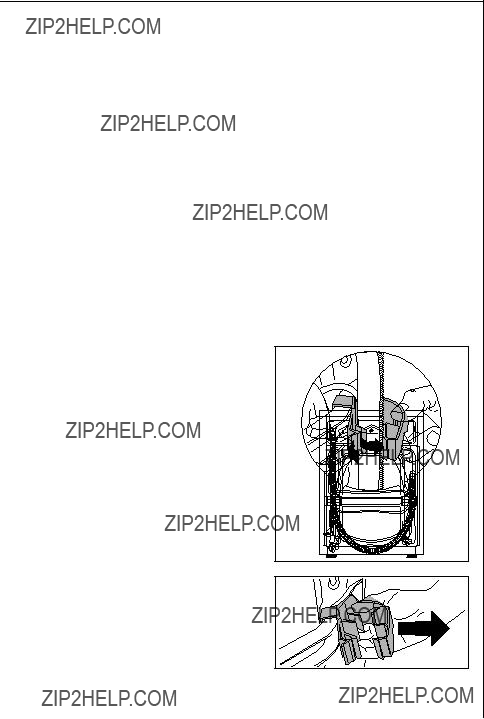
Installing the appliance
Transporting the appliance
1 Warning: The washing machine is very heavy. There is a risk of injury. Exercise care when lifting the appliance.
???Do not lay the washing machine on its front nor on its right side (as seen from the front). Electrical components may get wet.
???Never transport the appliance without using the transit packaging. Only remove the transit packaging when the appliance is in its place of installation. Transporting the appliance without the use of the transit packaging can cause damage to the appliance.
???Never lift the appliance by the door when it is open nor by the plinth.
When using a sack trolley to transport the washing machine:
??? Only use the sack trolley on the side of the appliance.
Removing the transit packaging
Important! Be sure to remove all the components of the transit pack- aging prior to using the appliance for the first time. Keep the transit packaging in a safe place, in case it is needed at a later date when the appliance is to be moved
(e.g. moving house).
1. Open the two hose retainers located at the rear of the appliance and re- move the hoses and electrical cable.
2. Remove the two hose retainers from the appliance with a strong tug.
37

3. Remove both plastic caps sideways.
3 Special spanner A and sealing caps B (2 units) and C (1 unit) come with the appliance.
4. Use special spanner A to remove screw D and the compression spring.
5. Turn sealing cap C upside down as shown in the illustration.
6. Use sealing cap C to cap the hole.
7. Use special spanner A to remove the two screws E.
8. Use special spanner A to remove the four screws F.
9. Remove transit bar G.
10. Screw in the four screws F again.
11. Use sealing caps B to cap the two large holes.
Important: Press all sealing caps B (2 items) and C (1 item) in firmly so that they snap into the rear wall.
Where to install
Important! The washing machine must not be operated in a room where there is a danger of frost. There is a risk of frost damage or ad- verse effect on the perfomance of the machine. Frost damage is not covered under the warranty.
???The surface on which the appliance is to be installed must be firm and level. Do not install the appliance on carpeted floors or soft floor coverings.
???The surface on which the appliance is to be installed must be clean and dry and free from grease, so that the appliance does not slide.
38

???If the location in which the appliance is to be installed is fitted with
If the appliance is to stand on a base:
In order for the appliance to be se- cure on the base, fixing plates*) must be mounted, into which the appliance is inserted.
If the appliance is to stand on a floor which moves, e.g. a suspend- ed wooden floor:
Place the appliance in an area as close as possible to a corner of the room.
Screw a
Making the appliance level
3 Automatic foot: The rear foot on the
The four feet of the appliance are
Large degrees of unevenness can be compensated for by individually ad- justing the height adjustable screw feet.
Use the special spanner supplied to do this.
Important Do not use pieces of wood, cardboard or such like to lev- el out unevenness in the floor, but adjust the height adjustable screw feet instead.
39

Electrical Connection
Any electrical work required to install this appliance should be carried out by a qualified electrician or competent person.
1 WARNING ??? THIS APPLIANCE MUST BE EARTHED.
The manufacturer declines any liability should these safety measures not be observed.
Before switching on, make sure the electricity supply voltage is the same as that indicated on the appliance rating plate.
The appliance is supplied with a 13 amp plug fitted. In the event of having to change the fuse in the plug supplied, a 13 amp ASTA ap- proved (BS 1362) fuse must be used.
Should the plug need to be replaced
for any reason, proceed as described below.
The wires in the mains lead are coloured in accordance with the following code:
??? The wire coloured green and yellow must be connected to the terminal marked with the letter ???E??? or by the
earth symbol E or coloured green and yellow.
???The wire coloured blue must be connected to the terminal ???N??? or coloured black.
???The wire coloured brown must be connected to the terminal marked ???L??? or coloured red.
???Upon completion there must be no cut, or stray strands of wire present and the cord clamp must be secure over the outer sheath.
1WARNING! A cut off plug inserted into a 13 amp socket is a serious safety (shock) hazard. Ensure that the cut off plug is disposed of safely.
40

Permanent Connection
In the case of a permanent connection it is necessary that you install a double pole switch between the appliance and the electricity supply (mains), with a minimum gap of 3mm between the switch contacts and of a type suitable for the required load in compliance with the current electrical regulations.
The switch must not break the yellow and green earth cable at any point.
This appliance complies with the requirements laid out in the EEC Di- rective 76/899.
Voltage 240 V AC: Fuse rating 13amps See rating plate for further information. This appliance meets VDE requirements.
Particular regulations of local electricity authorities must be observed. This appliance conforms to EEC Directive No. 82/499/EWG on radio in- terference.
1 WARNING! Repairs to electrical appliances must only be carried out by trained personnel. Improper repairs may lead to serious risks for the us- er.
Connecting the appliance to the water supply
Important:
???This appliance must not be connected to the hot water supply.
???When connecting the appliance, use only new hose kits.
???Only connect the appliance to the drinking water supply. Rain water or water for industrial use may only be used if it fulfils the require- ments of DIN1986 and DIN1988.
???Do not kink or crush the water inlet hose or drain hose.
Permitted water pressure
The water pressure must be at least 1 bar (=10N/cm2=0.1MPa), and may be a maximum of 10bar (=100N/cm2 =1MPa).
???If more than 10bar: Connect a pressure reduction valve.
???If less than 1bar: Disconnect the appliance end of the inlet hose from the solenoid inlet valve and remove the flow meter. (In addition re- move the filter using pointed pliers and take out the rubber gasket behind it.) Replace the filter.
41
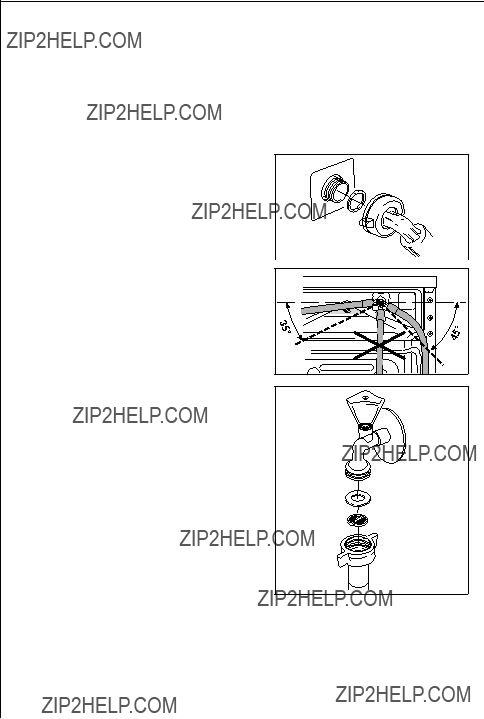
Water inlet
A 1.35m long pressure hose is supplied with the appliance.
If a longer inlet hose is required, only hoses from the manufacturer are to be used. Your local Service Force stocks hose kits of different lengths.
3 Sealing rings are either inserted in the plastic nuts of the threaded hose fitting or are included as spare parts. Do not use any other sealing rings.
Important! All threaded hose fit- tings must only be tightened by
hand. 1. Connect the hose with the
gle connector to the machine.
Important! Do not position the inlet hose vertically downwards. Position it to the right or the left as shown in the illustration.
2. Connect the hose with the straight connector to a water tap with an R ?? (inch) screw thread.
3. Slowly turn on the tap and check that all connections are watertight.
42

Water Drainage
The appliance drain hose should hook into a standpipe, the hook in the drain hose is formed using the plastic
Important! It is essential to lay the drainage hose without kinks. When discharging into a stand- 

pipe ensure that the top of the curve in the hose end is no more than 90 cm (35.4??????) and no less than 60 cm (23.6??????) above floor level.
The upright standpipe should have a minimum, length of 30 cm (12??????) from the bottom of the el-
bow to the top of the pipe (see diagram). Make sure that it is de- signed in such a way that the end of the drain hose cannot be cov- ered with water.
Longer drain hoses are available in lengths of 2.7 and 4 metres
from your Service Force Centre.
For drainage into an outlet
spigot: If the outlet spigot has not
been used before, remove any blank-
ing plug that may be in place. Push the drain hose onto the spigot and secure with a clip if required. Ensure the drain hose is looped upwards to prevent waste water from the sink
entering the washing machine.
Important! The end of the drainage hose must not be submerged in the
43

Pumping heights of over 1 metre
The washing machine???s drain pump is able to pump water to a height of 1metre, calculated from the surface on which the appliance is installed. Important! If pumping height is over 1 metre malfunctions and dam- age to the appliance may arise.
For pumping heights over 1metre a conversion kit can be obtained. Please contact Service Force Centre.
44

Warranty conditions
Great Britain
Standard guarantee conditions
We, AEG, undertake that if within 12 months of the date of the purchase this AEG appliance or any part thereof is proved to be defective by reason only of faulty workmanship or materials, we will, at our discretion repair or replace the same FREE OF CHARGE for labour, materials or carriage on condition that:
???The appliance has been correctly installed and used only on the electricity or gas supply stated on the rating plate.
???The appliance has been used for normal domestic purposes only, and in accordance with the manufacturer's operating and maintenance instructions.
???The appliance has not been serviced, maintained, repaired, taken apart or tampered with by any person not authorised by us.
???All service work under this guarantee must be undertaken by a Service Force Centre. Any appli- ance or defective part replaced shall become the Company's property.
???This guarantee is in addition to your statutory and other legal rights.
???Home visits are made between 8.30am and 5.30pm Monday to Friday. Visits may be available outside these hours in which case a premium will be charged.
Exclusions
This guarantee does not cover:
???Damage or calls resulting from transportation, improper use or neglect, the replacement of any light bulbs or removable parts of glass or plastic.
???Costs incurred for calls to put right an appliance which is improperly installed or calls to appli- ances outside the United Kingdom.
???Appliances found to be in use within a commercial environment, plus those which are subject to rental agreements.
???Products of AEG manufacture which are not marketed by AEG.
European Guarantee
If you should move to another country within Europe then your guarantee moves with you to your new home subject to the following qualifications:
???The guarantee starts from the date you first purchased your product.
???The guarantee is for the same period and to the same extent for labour and parts as exists in the new country of use for this brand or range of products.
???This guarantee relates to you and cannot be transferred to another user.
???Your new home is within the European Community (EC) or European Free Trade Area.
???The product is installed and used in accordance with our instructions and is only used domesti- cally, i.e. a normal household.
???The product is installed taking into account regulations in your new country.
Before you move please contact your nearest Customer Care centre, listed below, to give them de- tails of your new home. They will then ensure that the local Service Organisation is aware of your move and able to look after you and your appliances.
45

Weitere Kundendienststellen im Ausland
In diesen L??ndern gelten die Garantiebedingungen der ??rtlichen Part- ner. Diese k??nnen dort eingesehen werden.
Further
In these countries our
Autres agences ??trang??res assurant le service
Dans ces pays, les conditions de garantie des concessionnaires de la r??- gion sont valables. Vous pouvez les consulter sur place.
Otros puntos de Postventa en el extranjero
En estos pa??ses rigen las condiciones de nuestros representantes locales. las cuales pueden ser consultadas all?? mismo.
Ulteriori uffici del servizio tecnico assistenza clienti all???estero
In questi paesi sono valide le condizioni di garanzia dei partner locali. Queste condizioni possono essere esaminante sul luogo.
Servi??os de assist??ncia t??cnica no estrangeiro
Nestes pa??ses s??o v??lidas as condi????es de garantia dos concession??rios locais, podendo a?? ser consultadas.
Tov??bbi vev??szolg??lati irod??k k??lf??ld??n
Ezekben az orsz??gokban a mi
Servisne slu??be
Na garancijskem listu boste na??li seznam poobla????enih servisnih slu??b
46

Customer Service Centres
47

48

49

50
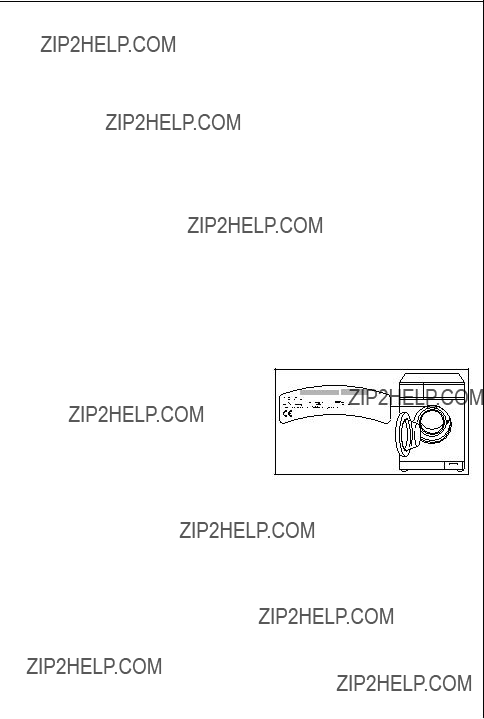
Service and Spare Parts
If the event of your appliance requiring service, or if you wish to pur- chase spare parts, please contact Service Force by telephoning:
0870 5 929 929
Your telephone call will be automatically routed to the Service Force Centre covering your post code area.
For the address of your local Service Force Centre and further informa- tion about Service Force, please visit the website at
www. serviceforce.co.uk
Before calling out an engineer, please ensure you have read the details under the heading ???What to do if...???
When you contact the Service Force Centre you will need to give the following details:
1.Your name, address and post code.
2.Your telephone number.
3.Clear and concise details of the fault.
4.The model and serial number of the appliance (found on the rating plate)
5.The purchase date.
Please note that a valid purchase re- ceipt or guarantee documentation is required for
Customer Care
For general enquiries concerning
your
Electrolux products please contact our Customer Care Department by
letter or telephone at the address below or visit our website at www.aeg.co.uk.
(*) Calls may be recorded for training purposes
51
 From the Electrolux Group. The world??s No.1 choice.
From the Electrolux Group. The world??s No.1 choice.
The Electrolux Group is the world??s largest producer of powered appliances for kitchen, cleaning and outdoor use. More than 55 million Electrolux Group products (such as refrigerators, cookers, washing machines, vacuum cleaners, chain saws and lawn mowers) are sold each year to a value of approx. USD 14 billion in more than 150 countries around the world.
AEG Hausger??te GmbH
Postfach 1036
?? Copyright by AEG